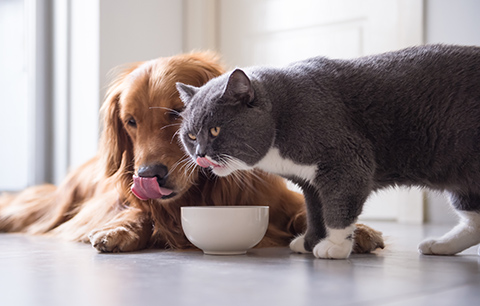How do I get help in choosing the right pet diet
With so many commercial cat and dog foods to choose from now, deciding which diet is best for your pet can be overwhelming. Do you buy Organic? Light? Grain-free? Raw? Fresh? Life-stage? What do the ingredients mean? Is wet better than dry?
Don’t worry, we know there’s a lot to consider, so we’ve put together a helpful guide to ensure your pet looks forward to meal times.
The best place to start is to think about your pets nutritional needs, breed and life stage. Like us, pets are individuals and at some point in their lives could develop health conditions that will require their diet to change. Unfortunately not all commercial foods will be suitable and some pets may need a special/veterinary diet. If your pet has a health condition or you have any concerns, speak to your vet and ask if there is diet that can help.
You can find out more about special/veterinary diets here.
For pets without specific health conditions, most commercial pet food products on the market are designed to provide total nutrition. These products will have the term ‘complete’ on the pet food packet. Balancing the right quantities of protein, fat, fibre and carbohydrates along with the specific vitamins, minerals and fatty acids.
You will find that leading pet food manufacturers offer a range of these products which provide nutritional support for common cat/dog types, issues and life stages. For example, neutered pets, life-stage, size/breed & common health conditions (dental, digestion, skin)
The benefits of ‘complete’ pet food
When quality ‘complete’ foods are given to your pet (in the correct quantities) you can expect they will provide:
- Good digestion
- Great coat condition
- Optimum joint health
- Healthy skin
- Optimum body weight
- Dental health
Ingredients
Here’s some of the most important ingredients to look out for when choosing a quality commercial pet food:
- Animal protein – This should be at the top of the list, forming the majority of the recipe content. Meats are generally good sources of protein, essential fatty acids, iron and some B group vitamins. They also increase the palatability of a product and have a high digestibility. Quality foods will name the source of the protein, e.g. lamb, beef, fish, chicken etc. (Avoid foods which simply list “meat” or “meat meal” as the highest ingredient)
- Fish is a good source of high quality protein. Because bones are frequently ground when preparing the fish, a good source of calcium and phosphorus is also provided. The flesh of oily fish contains vitamin A & D and omega 3.
- Supporting animal meal (when fresh meat is listed first on the list) – this additional source of protein from animal meal (skin/bone/tissue) contains a lot of protein and supports the initial protein source. Again you should looked for named meal such as beef meal or chicken meal rather than just “animal meal”.
- Vegetables – provide a great source of complex vitamins, enzymes and antioxidants, but should appear lower down the list, rather than up there as a main ingredient.
- Cereals (Carbohydrate)- provide an important source of energy, a proportion of protein and other nutrients including thiamine and niacin. Good sources of carbohydrates in pet foods are usually cereal based such as corn (maize), rice, wheat, barley or sorghum.
- Additional oils, minerals and vitamins – certain recipes are developed to contain more nutrients for specific reasons. Read the ingredients to see what benefits each brand contains, some may have more beneficial additions than others.
- Preservatives- can be artificial or natural, but either way they work by preventing the spoilage of food ingredients just like in our food. Canned pet foods are protected from spoilage by their airtight storage in the can, but dry foods, even with modern packaging, must include preservatives to maintain the quality and safety of the food.
- Antioxidants- Dietary antioxidants play a substantial role in the long term health and well being of cats. Some manufacturers may add biological antioxidants e.g. vitamins C & E and selenium, to pet foods to help support good health and neutralise free radicals.
Advice: Do not try to compare protein levels between dry and wet food recipes. Dry food seems to have more in it because the protein is concentrated into smaller amounts of food and your pet eats less of it.
Wet food has more moisture, so pets eat more to feel full, and while protein levels are not as concentrated, by the time your pet has finished their meal, if they’re eating the correct amount, they too should have received the correct level of protein.
Cheap vs premium pet food. Do they have the same ingredients?
Not all commercial pet food is nutritionally balanced. It is a case of, ‘you get what you pay for’ Many cheaper diets claim to have the ‘finest’ ingredients or ‘guaranteed’ to improve coat etc. However, most of these cheaper diets include very little meat in their recipes, choosing instead to bulk their food with cheap fillers such as cereal, grain, preserving agents, as well as excess salt and flavourings to enhance the food’s palatability.
Even if your pet loves the taste of cheaper food, the lack of nutritional balance could soon cause some health issues as they grow older and increase the cost of care. It’s worth considering the cost of a more expensive food now compared to the cost of vet bills later on.
The most important factor to remember when feeding your pet is to give them a complete and balanced diet, appropriate for their species and life-stage. If your pet does have a medical condition, talk to your vet about their diet.
Don’t forget, Animed Direct sells a huge range of dog and cat foods, (including prescription only diets) at vastly reduced prices.
Source: www.pfma.org.uk
